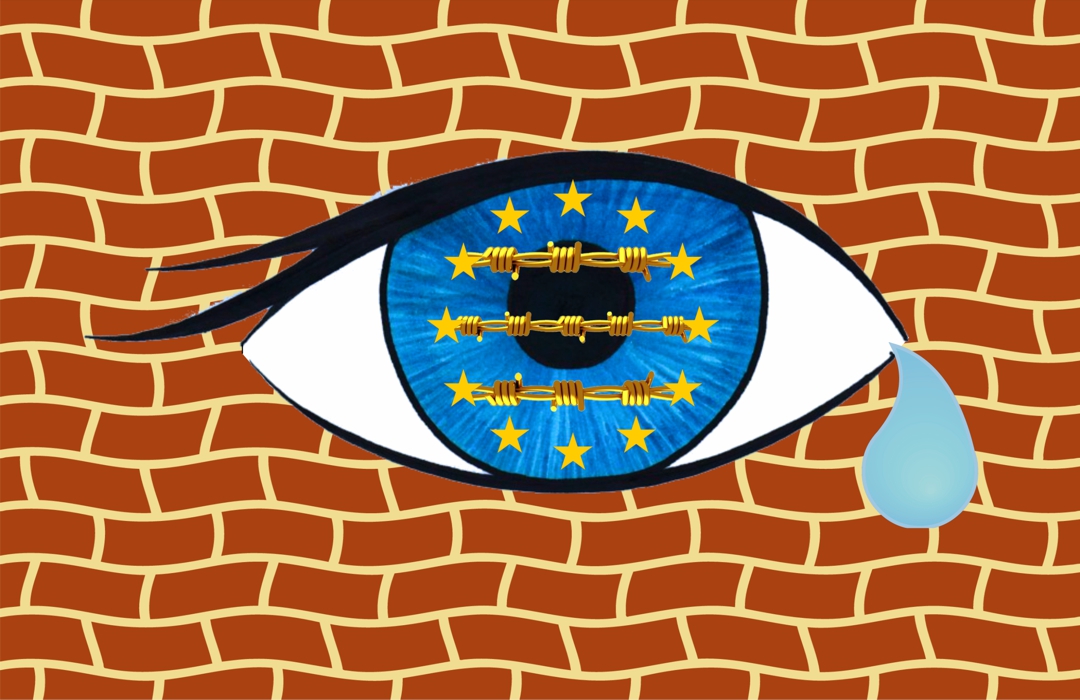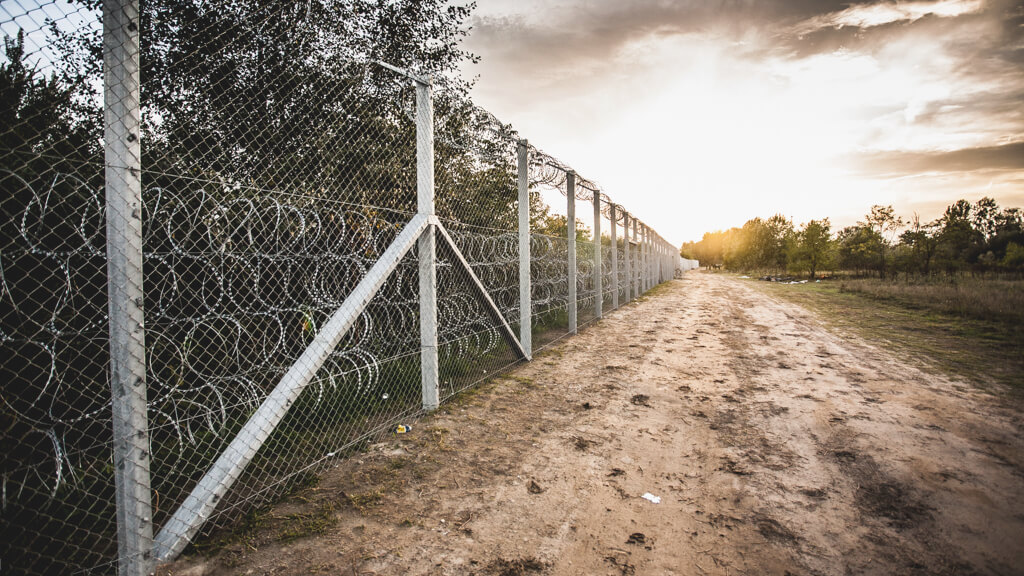
The report from Transnational Institute reveals that member states of the European Union and Schengen Area have constructed almost 1000 km of walls, the equivalent of more than six times the total length of the Berlin Wall.
by European Alternatives
Collage by Isles of the Left
This article was originally published on our friends’ site Political Critique.
[dropcap]O[/dropcap]n November 9th 1989, the Berlin Wall fell, marking what many hoped would be a new era of cooperation and openness across borders. German President Horst Koehler celebrating its demise some years later spoke of an ‘edifice of fear’ replaced by a ‘place of joy’, opening up the possibility of a ‘cooperative global governance which benefits everyone’. 30 years later, the opposite seems to have happened. Edifices of fear, both real and imaginary, are being constructed everywhere fuelling a rise in xenophobia and creating a far more dangerous walled world for refugees fleeing for safety.
This report from Transnational Institute reveals that member states of the European Union and Schengen Area have constructed almost 1000 km of walls, the equivalent of more than six times the total length of the Berlin Walls, since the nineties to prevent displaced people migrating into Europe. These physical walls are accompanied by even longer ‘maritime walls’, naval operations patrolling the Mediterranean, as well as ‘virtual walls’, border control systems that seek to stop people entering or even traveling within Europe, and control movement of population. Europe has turned itself in the process into a fortress excluding those outside—and in the process also increased its use of surveillance and militarised technologies that has implications for its citizens within the walls.
[beautifulquote align=”left” cite=””]Post-9/11 has transformed Europe’s policies from a more social agenda to one centered on security, in which migrations and the movements of people are considered as threats to state security.[/beautifulquote]
The report seeks to study and analyse the scope of the fortification of Europe as well as the ideas and narratives upon which it is built. This report examines the walls of fear stoked by xenophobic parties that have grown in popularity and exercise an undue influence on European policy. It also examines how the European response has been shaped in the context of post-9/11 by an expanded security paradigm, based on the securitization of social issues. This has transformed Europe’s policies from a more social agenda to one centered on security, in which migrations and the movements of people are considered as threats to state security. As a consequence, they are approached with the traditional security tools: militarism, control, and surveillance.

Europe’s response is unfortunately not an isolated one. States around the world are answering the biggest global security problems through walls, militarisation, and isolation from other states and the rest of the world. This has created an increasingly hostile world for people fleeing from war and political prosecution.
The foundations of “Fortress Europe” go back to the Schengen Agreement in 1985, that while establishing freedom of movement within EU borders, demanded more control of its external borders. This model established the idea of a safe interior and an unsafe exterior.
[beautifulquote align=”left” cite=””]Successive European security strategies after 2003, based on America’s “Homeland Security” model, turned the border into an element that connects local and global security.[/beautifulquote]
Successive European security strategies after 2003, based on America’s “Homeland Security” model, turned the border into an element that connects local and global security. As a result, the European Union Common Foreign and Security Policy (CFSP) became increasingly militarised, and migration was increasingly viewed as a threat.
Fortress Europe was further expanded with policy of externalization of the border management to third countries in which agreements have been signed with neighbouring countries to boost border control and accept deported migrants. The border has thus been transformed into a bigger and wider geographical concept.
Frontex: the Walls’ Borderguards
The European Border and Coast Guard Agency (Frontex) plays an important role in this whole process of fortress expansion and also acts and establishes coordination with third countries by its joint operation Coordination Points. Its budgets have soared in this period, growing from 6.2 million in 2005 to 302 million in 2017.
An analysis of Frontex budget data shows a growing involvement in deportation operations, whose budgets have grown from 80,000 euros in 2005 to 53 million euros in 2017. The European Agency for the Border and Coast Guard (Frontex) deportations often violate the rights of asylum-seeking persons. Through Frontex’s agreements with third countries, asylum-seekers end up in states that violate human rights, have weak democracies, or score badly in terms of human development (HDI).

Walls of Fear and the Influence of the Far-Right
The far-right have manipulated public opinion to create irrational fears of refugees. This xenophobia sets up mental walls in people, who then demand physical walls. The analysed data shows a worrying rise in racist opinions in recent years, which has increased the percentage of votes to European parties with a xenophobic ideology, and facilitated their growing political influence. In 28 EU member states, there are 39 political parties classified as extreme right populists that at some point of their history have had at least one parliamentary seat (in the national Parliament or in the European Parliament).
At the completion of this report (July 2018), 10 member states (Germany, Austria, Denmark, Finland, France, Netherlands, Hungary, Italy, Poland and Sweden) have xenophobic parties with a strong presence, which have obtained more than half a million votes in elections since 2010. With the exception of Finland, these parties have increased their representation. In some cases, like those in Germany, Italy, Poland and Sweden, there has been an alarming increase, such as Alternative for Germany (AfD) winning 94 seats in the 2017 elections (a party that did not have parliamentary representation in the 2013 elections), the Law and Justice party (PiS) in Poland winning 235 seats after the 2015 elections (an increase of 49%), and Lega Nord’s (LN) strong growth in Italy, which went from 18 seats in 2013 to 124 seats in 2018.

The study concludes that, in 9 of these 10 states, extreme right-wing parties have a high degree of influence on the government’s migration policies, even when they are a minority party. In 4 of them (Austria, Finland, Italy and Poland) these parties have ministers in the government. In 5 of the remaining 6 countries (Germany, Denmark, Holland, Hungary, and Sweden), there has been an increase of xenophobic discourse and influence.
[beautifulquote align=”left” cite=””]The positions of the most radical and racist parties are amplified with hardly any effort.[/beautifulquote]
Even centrist parties seem happy to deploy the discourse of xenophobic parties to capture a sector of their voters rather than confront their ideology and advance an alternative discourse based on people’s rights. In this way, the positions of the most radical and racist parties are amplified with hardly any effort. In short, our study confirms the rise and influence of the extreme-right in European migration policy which has resulted in the securitization and criminalization of migration and the movements of people.
The mental walls of fear are inextricably connected to the physical walls. Racism and xenophobia legitimise violence in the border area Europe. These ideas reinforce the collective imagination of a safe “interior” and an insecure “outside”, going back to the medieval concept of the fortress. They also strengthen territorial power dynamics, where the origin of a person, among other factors, determines her freedom of movement.
In this way, in Europe, structures and discourses of violence have been built up, diverting us from policies that defend human rights, coexistence and equality, or more equal relationships between territories.
The complete report is available here.